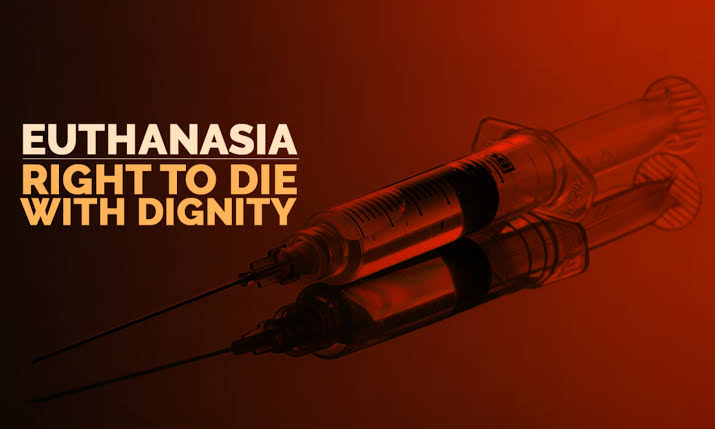EUTHANASIA AND RIGHT TO DIE
Introduction:
Euthanasia is the practice of deliberately ending an individual’s life, typically physician-assisted, to eliminate suffering caused by a terminal illness, unbearable pain, or a condition that severely impairs their quality of life. It can be in different forms, including active euthanasia, where a specific action is taken to cause death, and passive euthanasia, where life-sustaining treatments are withheld, allowing a natural death to occur.
The right to die with dignity refers to an individual’s freedom and their fundamental human right to make decisions about their own life, including the choice to end their life under certain circumstances. It encompasses the idea that individuals, particularly those with terminal illnesses, should have the option to die peacefully and without unnecessary suffering while maintaining their dignity.
Ethical arguments in favor of euthanasia emphasize the principles of individual autonomy and compassion for those suffering. Opponents raise concerns about the sanctity of life, the potential for abuse, and the ethical role of healthcare professionals in causing death.The legal landscape varies globally, with some countries legalizing euthanasia under strict regulations, while others maintain its criminalization.
Historical Context of Euthanasia:
Euthanasia’s historical roots can be traced back to ancient civilizations, where practices resembling mercy killing and assisted dying were documented. In ancient Greece, for instance, philosophers like Plato and Socrates discussed the moral implications of euthanasia. They viewed it as a means to escape prolonged suffering and as an exercise of rational choice.
Similarly, in ancient Rome, the Stoics considered voluntary death an honorable choice for those facing unbearable pain or terminal illness. These early discussions set the stage for ongoing debates about euthanasia.
Over time, religious, cultural, and ethical perspectives have significantly shaped the perception of euthanasia. In many cultures, religious beliefs have played a crucial role in defining the sanctity of life and the prohibition of taking human life, even to alleviate suffering. For example, Christianity, Judaism, and Islam traditionally oppose euthanasia based on the belief that life is sacred and should be preserved.
Cultural norms also influence attitudes toward euthanasia. Some societies place a strong emphasis on filial piety, affecting the decisions of family members regarding end-of-life care. Ethical perspectives have evolved, with a growing recognition of individual autonomy and the right to die with dignity, often leading to calls for legal reforms.
In sum, the historical development of euthanasia dates back to ancient civilizations, while contemporary perspectives on the subject are deeply rooted in religious, cultural, and ethical frameworks. These diverse viewpoints continue to shape the ongoing debate over euthanasia and the right to die with dignity.
Euthanasia in India:
The legal status of euthanasia in India is a subject of significance and complexity. As of my last knowledge update in January 2022, India had not passed a comprehensive law specifically addressing euthanasia. However, India’s approach to euthanasia is guided by judicial decisions, creating a legal framework for specific circumstances. The most notable cases have allowed for “passive euthanasia,” which involves the withholding or withdrawal of life-sustaining treatment in cases of unbearable suffering. While active euthanasia, where a positive action is taken to end life, is still illegal, the concept of passive euthanasia is recognized and governed by legal and ethical principles.
Euthanasia in India includes two primary forms: passive euthanasia and active euthanasia. Passive euthanasia involves the withholding or withdrawing of life-sustaining treatments, allowing a natural death to occur. Active euthanasia, on the other hand, involves a intentional action, such as administering a lethal dose of medication, to end the life of a person. In India, passive euthanasia is accepted under certain circumstances when it is based on competent medical advice and authorized by a High Court.
The “Aruna Shanbaug” case (2011) was a pivotal moment in shaping India’s euthanasia laws. In this case, the Supreme Court of India recognized the concept of passive euthanasia and laid down guidelines for its application. The “Common Cause” case (2018) further clarified the legal framework for passive euthanasia, introduced the concept of “living wills,” and affirmed the right to die with dignity as a fundamental aspect of the right to life.
These cases have had a significant impact on India’s approach to euthanasia, emphasizing the importance of respecting an individual’s autonomy and right to a dignified death, particularly in cases of terminal illness and unbearable suffering.
The Ethical Debate:
Ethical arguments in favour of euthanasia stress the principles of individual autonomy, emphasizing that individuals have the right to make decisions about their own lives, Including choosing when and how to end their suffering. Compassion plays a pivotal role, highlighting the moral obligation to alleviate unbearable pain and allow individuals to die with dignity, minimizing their physical and emotional distress. These arguments underscore the importance of respecting personal values and preferences in end-of-life decisions.
Ethical concerns opposing euthanasia centre on the sanctity of life, asserting that life is inherently valuable and should not be intentionally ended. Worries about potential abuse include scenarios where vulnerable individuals might be coerced into euthanasia. Additionally, ethical considerations revolve around the role of healthcare professionals, who may be conflicted between preserving life and honoring patient autonomy, raising complex moral dilemmas in end-of-life care.
Legal Framework:
Countries with established euthanasia laws typically have well-defined legal frameworks. For example, the Netherlands and Belgium allow both euthanasia and physician-assisted suicide under specific conditions, including the presence of unbearable suffering and informed consent. In these nations, physicians must adhere to strict guidelines and reporting requirements. In Switzerland, assisted suicide is permitted under specific conditions.
India’s legal approach to euthanasia is distinct from these nations. India does not have a comprehensive law addressing euthanasia. Instead, the legal landscape is shaped by judicial decisions, allowing for passive euthanasia in certain cases based on competent medical advice and High Court authorization. Active euthanasia remains illegal.
Living wills and advance directives play a significant role in end-of-life decision-making in many countries. In India, the “Aruna Shanbaug” and “Common Cause” cases have recognized the importance of living wills. These legal documents allow individuals to express their preferences for end-of-life care, making sure that their wishes are honored in the event they become incapacitated.
India’s Constitution also guarantees the right to life under Article 21, which the Supreme Court has interpreted to include the right to die with dignity. In contrast, other nations have comprehensive legislation governing euthanasia, providing a more structured legal framework.
Right to Die with Dignity:
The concept of the “right to die with dignity” is deep-seated in the fundamental principle of individual freedom and human rights. It emphasizes that every person has the right to make decisions about their own life, including the choice to end their life when faced with unbearable suffering, terminal illness, or a degraded quality of life. This right recognizes the intrinsic value of preserving human dignity, allowing individuals to assert control over their final moments.
The importance of this concept lies in mitigating unnecessary suffering, affirming a person’s ability to die peacefully, and maintaining their integrity in the face of profound physical or emotional distress. It seeks to honor the individual’s unique experiences and values, prioritizing their well-being and choices as central to the concept of human dignity.
Real-life examples underscore the significance of the “right to die with dignity.” A concerned case is that of Brittany Maynard, a young woman diagnosed with terminal brain cancer. She relocated to a state in the United States where medical aid in dying was legal and chose to end her life on her terms to avoid the suffering of her condition. Her decision stirred a global debate, highlighting the importance of personal autonomy and dignity in end-of-life choices. These cases demonstrate the profound impact of this concept on individuals facing extreme suffering and their quest for a compassionate and dignified death.
Case Studies:
Notable international euthanasia cases such as Brittany Maynard and Vincent Humbert have raised profound legal and ethical questions. Brittany Maynard, a terminally ill patient in the United States, publicly advocated for medical aid in dying, emphasizing the importance of individual autonomy and compassion. Her case sparked conversations on end-of-life choices and contributed to legal reforms in some U.S. states.
Vincent Humbert’s case in France involved his mother’s request for euthanasia to end his suffering after a tragic accident left him quadriplegic and unable to communicate. The legal implications of this case underscored the complexities of end-of-life decisions, with France having stringent laws against euthanasia.
Comparing these international cases with Indian examples reveals differences in legal outcomes. In India, the “Aruna Shanbaug” and “Common Cause” cases have primarily focused on passive euthanasia, allowing for the withholding or withdrawal of life support in specific cases. Active euthanasia remains illegal in India.
While both sets of cases emphasize the importance of individual autonomy and compassion, the legal frameworks differ. In some countries, like the Netherlands and Belgium, comprehensive laws govern euthanasia under strict conditions, while India relies on judicial decisions and lacks comprehensive legislation. These differences reflect varying cultural, legal, and ethical perspectives on euthanasia and the right to die with dignity.

Safeguard and Regulations:
In countries where euthanasia is legal, strict safeguards and regulations are in place. These typically include a thorough assessment process, multiple medical opinions, and the need for the patient’s informed consent. Healthcare professionals follow precise procedures to ensure that the patient’s decision is voluntary and well-considered. Oversight and reporting mechanisms are integral to monitor and review cases to ensure compliance with the law.
The Importance of strict guidelines lies in protecting vulnerable populations. Without rigorous regulations, there is potential for abuse or coercion, endangering those who might not be in a position to make an informed and voluntary decision about euthanasia. Stringent safeguards are essential to balance the right to die with dignity with the protection of those who may be vulnerable or subject to undue influence.
Conclusion:
Balancing individual autonomy and the preservation of life is a delicate ethical and legal challenge. While respecting an individual’s right to decide their own fate is crucial, it must be weighed against the sanctity of life and safeguards to prevent potential abuse. Euthanasia laws are continually evolving, reflecting changing societal values and medical advancements. The right to die with dignity is becoming more recognized worldwide, but the fine equilibrium between personal choice and the value of life remains a complex and evolving issue, shaped by cultural, legal, and ethical factors.
Author: Tamanna Mishra, a student of Faculty of Law, Delhi University



